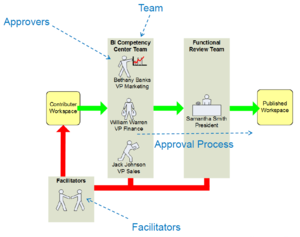
At the
wonderful new offices of
ISI,
Balanced Insight presented their story about collaborative BI as offered in their Consensus product.
Tom Hammergren, Founder/CEO, and
Mike Venerable, Board Member, lead the discussion. Mike and Tom are both long time BI/DW industry folks. Mike wrote a book with Chris Adamson and was the leader of Talus, who was acquired by Sagent, who was acquired by Pitney Bose, etc. Tom was also on the founding team at Cognos when they created PowerPlay and Impromptu and the developer of the Sybase Warehouse Studio. Tom has three DW books out there, including the latest update of
Data Warehousing for Dummies.
Balanced Insights was founded in 2003 by several BI veterans (like Tom) with seed funding. They have been profitable with cash flow positive. They have a 20-25 notable customers, such as Fidelity Investments, Nationwide Insurance, T-Moble, AT&T, Nike, and Subway.
Tom noted that their target is the leader of BI within the IT group. However, the motivation comes mainly from the business users who have clear business problems and are aware of the potential of BI/DW to solve those problems. Their vision is
combining social software with BI delivery software to increase our customer’s fact based decision making capabilities by providing a collaborative BI ecosystem.
Tom argues... Current BI delivery is challenged by being inefficient and labor intensive, with business users disconnecting when dealing with the technical issues. As the business demands bigger information, the need for higher project velocity requires Agile BI Development. Tom summarized, "How our Consensus product engages people is wildly different than other Agile BI tools." " The Consensus tool interfaces (builds upon) BI suites (Business Objects, Cognos, etc.) with OLAP tools (Cognos DMR, Microsoft SSAS, etc.) and data warehouses (IBM DB2, MySQL, Oracle, Netezza, etc.).

As far as engaging users, Tom went over an example of Consensus’ collaborative approval workflow process. This capability is engineered into the agile development activities so that each BI deliverable can be reviewed by a broad set of distributed users with all feedback recorded for future reference within the Consensus Repository.
A
Forrester report reviewed several related vendors according to a variety of criteria. Tom argued that many of these vendors do not overlap on their core functions. Going through customer examples, Tom summarized their value proposition as: Fast with half the time, Productive with half the cost, and Engaging with continuous feedback.
Cindi Howson asked about integration among the various BI tools through the development steps. Tom gave several examples of how the data structures of one tool in migrated into another stage to be use by another tools.
Tom ended with their future plans (which is confidential).
My Take...Balanced Insight is focusing on a very important aspect of BI/DW - effective collaborative BI, amid typical infrastructures composed of diverse fragmented tools. This is quite a challenge! Their vision is to do end-to-end collaborative BI; however, at this stage, they are doing collaborative BI
delivery. Tom mentions agile development, but they need to clearly link into the framework and terminology of agile development process.
The challenge for Balanced Insight to provide the full BI ecosystem is the definition of the BI function layer that sits over various technical layers, such as user access, target data, data movement, data quality, and source data. What is the business value proposal behind providing this BI layer? Digging into this question should reveal the chaos (and inefficiencies and risk) in the ad hoc activities that characterize most BI projects. Balanced Insights need to make that messy situation vividly clear in their market positioning and then leverage it.